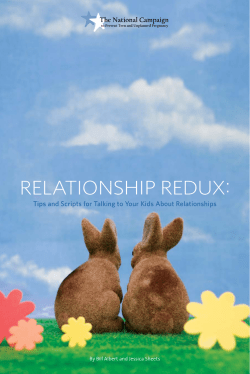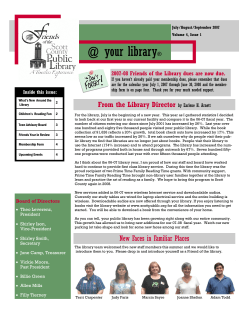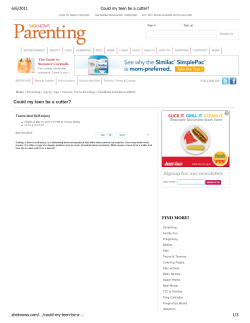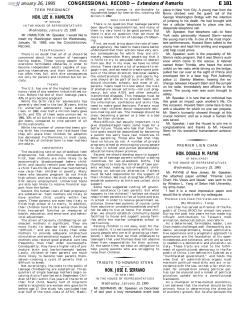
SAN MATEO COUNTY NARCOTIC TASK FORCE WHAT PARENTS NEED TO KNOW
SAN MATEO COUNTY NARCOTIC TASK FORCE WHAT PARENTS NEED TO KNOW While many people associate spring break with college kids, the San Mateo County Narcotic Task Force is urging parents of high school teens to know the risks associated with this time of the year. More teens than ever are putting themselves at risk during spring break and the summer months. More than ever high school students under the age of 18 take unsupervised trips during spring break or during summer months but even teens that stay at home are at risk. Unsupervised time, money to spend and peer pressure to “let loose” can be a recipe for risky behavior including drug use. We are calling on parents to take action during this period whether their teen is staying home or going away on a spring break trip. SET RULES: No drinking / No drugs -Be clear and specific about your expectations. Spring Break should not mean a break from responsibility. -Talk candidly about the risks of drug use and binge drinking including poisoning, violence, sexual assault and sexually transmitted diseases. PREPARE YOUR TEEN: -Give teens tips on how to protect themselves, such as using a buddy system and watch out for each other. -Discuss different scenarios and discuss how to handle pressures, including offers of drugs or alcohol and other risky situations. KEEP MONITORING: -Know what your teen is doing or their itinerary, where he/she is staying -If your teen is staying at home, know how they are spending their unsupervised time -Ask questions. Require daily check-in via cell phone and make sure your teen is reachable. Make sure to have cell phone numbers for your teens friends and check in with them as necessary too. -Network with and connect with other parents to confirm plans and coordinate ground rules. TO SNOOP OR NOT TO SNOOP? It is a controversial topic, but if you suspect your child is drinking or using drugs, snooping can help keep your children safe. In an effort to bring awareness to parents of teens and the general public, the San Mateo County Narcotics Task Force has created a list of items that might be in your child’s backpack. The following items, that you might not be aware of, are based on local trends of drug use amongst teens in our neighborhoods. Ask your child……………………… “What’s in your backpack?” “Purple Dank”, “Syrup”, “Lean”, “Sizzurp” By adding cough syrup with codeine to a soft drink and candy, usually Robitussin DM, Sprite and Jolly Ranchers, teens create what they consider a quick remedy for tension, anxiety and aggression. There are many side affects but in large doses this substance causes hallucinations and a single use can be lethal to an inexperienced user “OC”, “Oxy”, “Percs”, Vikes”, “Happy Pills”, “Narcos” There is a reason prescription drugs are intended to be taken under a doctor’s direction: If used improperly, they can be dangerous. Despite what teens or parents might think, abusing prescription drugs is NOT safer than using illicit drugs. Prescription drugs can have dangerous short and long term health consequences when used incorrectly. Look for Opioids such as OxyContin and Vicodin, central nervous system depressants such as Xanax, Valium and stimulants such as: Concerta, or Adderall. “Laughing gas”, “snappers”, “poppers”, “whippets”, “bold” and “rush” Inhalants are chemical vapors that are inhaled for the purpose of getting “high”. The vapors produce mind altering and sometime disastrous effects. Locally, more and more teens are using “whippets” (fluorinated hydrocarbons, found in whipped cream dispensers) or nitrous oxide filled balloons. Spice: “K2”, “Fake Weed”, “Moon Rocks”. Spice is a mix of herbs that can produce experiences similar to marijuana. Spice mixtures are sometimes marked as “natural” legal alternatives to marijuana but are labeled “not for human consumption”. They contain dried shredded plant material along with manmade chemicals that cause the mind altering effects. The chemicals used in Spice have a high potential for abuse and no medical benefit. Bath Salts: “Bloom”, “Cloud Nine”, “White Lightning” Bath Salts are relatively new manmade chemicals related amphetamine-like stimulant found naturally in the khat plant. There have been reports of sever intoxication and dangerous side effects from the use of this from the use of bath salts. The synthetic cathinones in bath salts can produce feelings of joy and increased sociability and sex drive but abuse can leave people experiencing paranoia, agitation, hallucinations, people lose contact with reality and act violently and there have several reports deaths. MDMA (Ecstasy or Molly): “E”, “X”, “Beans”, “Love Drug”, “Club Drug” Ecstasy or Molly are slang terms for a drug that has effects similar to those of other stimulants and it often makes the person feel like everyone is his/her friend, even when that is not the case. MDMA is man made, it does not come from a plant. Makers of these pills can add anything they want to the drug so the purity is always in question. Marijuana: “Pot”, “Grass”, “Weed”, “Wax” Marijuana contains the chemical called delta-9-tetrahydrocannabinol, better known as THC. The THC content of marijuana has been increasing since the 70’s. Estimates from locally seized marijuana indicates that the marijuana is as low as 10% and as high as 30% THC. Some are converting the marijuana to hash oil using butane, which can be very explosive. The TCH content of hash oil is estimated to be between 40% and 85%. Do you think e-cigarettes are safe? Many teens are using these e-cigarettes to ingest the hash oil by removing the liquid from the e-cigarettes and replacing it with the hash oil. The hash oil is dark in color and odorless. Knowledge is power and it is ok to ask…………….… “What’s in your backpack?”
© Copyright 2025





















